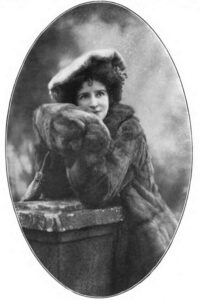
The House by the Lock
“Hullo, old chap! Who would ever have thought of seeing you here tonight? What’s brought you back to civilization again?”
I turned suddenly, surprised by the sound of a familiar voice in my ear. It was the night of Christmas Eve, and I was just entering the lobby of St. James’s, the first time, as it happened, I had seen the inside of a theatre for two years.
For a fraction of a moment, I could not remember where I had known the man who addressed me so jovially. My way of knocking about the world brought me into contact with so many people that it was difficult to sort my gallery of faces and keep each one mentally ticketed. But after a second or two of staring through that convenient medium, my monocle, I was able to place the man who had accosted me. He was a rich mining king from Colorado, by the name of Harvey Farnham, whom I had met in Denver when I had been dawdling through America three or four years ago.
I pronounced his name with a certain self-satisfaction in having so readily recalled it, and we shook each other by the hand.
“What’s brought me back to civilization?” I echoed, lazily. “I don’t know–unless it was because I’d got tired of the other thing. Adventure–change–that’s what I am in search of, my dear Farnham.”
“And you come back here from service as war correspondent in Egypt (where I last read of you in the papers as having been carried down a cataract for twenty-six miles before a launch ran out and saved you) in the hope of finding ‘adventure’ in this workaday close of the nineteenth century? That’s too good.”
I laughed and shrugged my shoulders. “Yes; why not? Why should there not be as great a possibility of obtaining new sensations, or at least old ones in different forms, in London as anywhere else?”
It did not occur to me, as I idly spoke the words, that I was uttering a prophecy.
“How is it,” I went on rather curiously, “that you remembered me, ‘honoring my draft on sight,’ so to speak? It must be four years since that very jolly supper you gave me in Denver one night, and I fancy I have changed considerably since then.”
Read or download Book
A. M. Williamson
Alice Muriel Williamson (8 October 1858 – 24 September 1933), who published chiefly under names the “C. N. and A. M. Williamson” and “Mrs. C. N. Williamson,” was an American-English author.
Biography
She was born on 8 October 1858 to parents Marcus and Jane (Thomas) King in Cleveland, Ohio, where her father was co-founder of the Ohio State and Union Law College. In 1890 she adopted the surname “Livingston” from her maternal great-grandfather following her separation from her first husband, Lieutenant William Reeve Hamilton, who disapproved of her budding career as an actress. In 1892 she expatriated herself to England (and from her first husband) as a foreign correspondent for the Boston Evening Transcript, supplying that paper with approximately 120 “letters” between 1892 and 1897 before devoting herself full-time to fiction, although she remained a occasional freelance journalist for the rest of her life. Two years after arriving in England she married magazine editor Charles Norris Williamson (1857–1920) whom she persuaded to appear as co-author for many of her books, later acknowledging her sole authorship.
Her success as an author, in its early stages, was owing to Alfred Harmsworth who, recognizing her talent, promoted her stories – especially sensational serials – in the Daily Mail and his many other publications. Her first serial, “Confessions of a Stage-Struck Girl,” appeared in Forget-Me-Not (August 11-November 17, 1894), partly inspired by her earlier career as an actress in America, as was her first novel, The Barnstormers (1897), written at the suggestion of S. R. Crockett upon hearing her describe some of her theatrical experiences at a dinner party. Her second novel, A Woman in Grey (1898), established her reputation as a worthy successor to Wilkie Collins. A third, The Newspaper Girl (1899), exploited Elizabeth Banks’s “stunt” journalism, turning some of the same stratagems to humorous effect. Humor would become one of her most striking characteristics as an author, beginning with The Lightning Conductor (1902), the novel that catapulted her overnight to international fame, selling more than a million copies in America. James Milne, in Memoirs of a Bookman (1934), speaks of a “tradition” that she was “the wittiest girl who ever invaded Fleet Street.”
Although best known for her series of motor travel romances, she was a literary polymath adept at a wide variety of genres (detective, mystery, Gothic, spy, adventure, war, ghost, fairy, satire, fictional memoir, muckraking, etc.), often published anonymously or pseudonymously, such as Champion: The Story of a Motor Car (1907) as by John Colin Dane (memoirs narrated by the car itself), and her sensational exposé of German war plans on the eve of World War I, What I Found Out in the House of a German Prince (1915), purporting to be “by an American-English Governess,” the latter so realistic that it was accepted as a true account and published serially in the Fortnightly Review.
She died on 24 September 1933 under strange circumstances at Bath, where her remains are interred next to those of her husband in the graveyard behind Bath Abbey.






